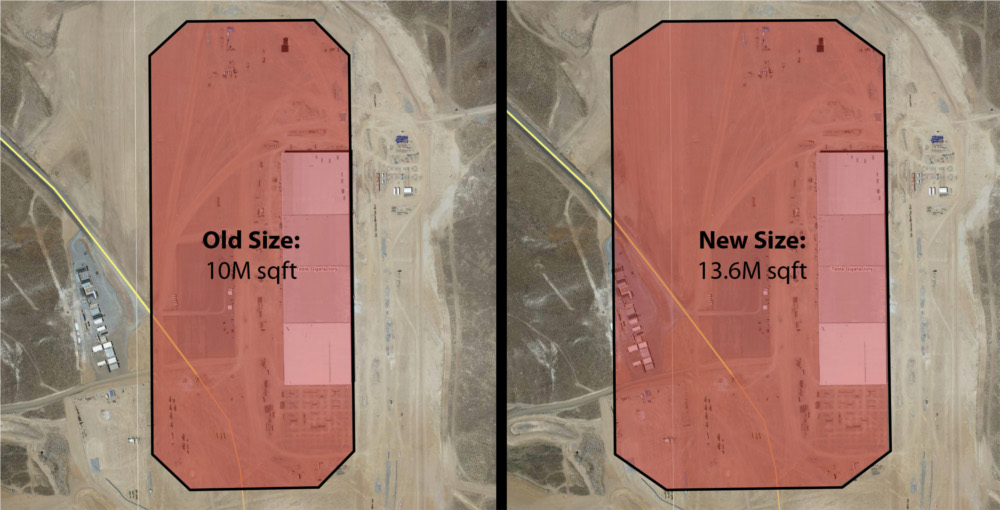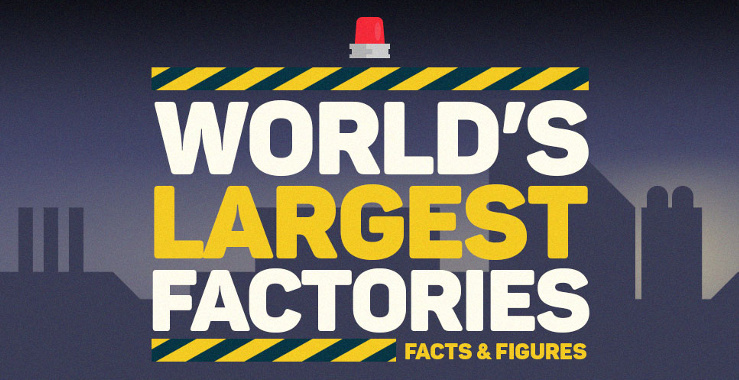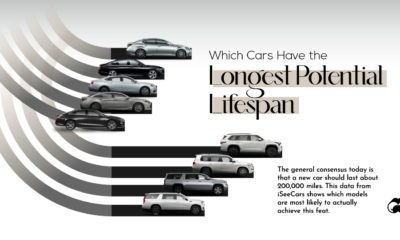Like many other modern goods, they get made in manufacturing plants that are designed to produce at scale. However, the factories pumping out the world’s cruise ships and electric cars are anything but ordinary. Most of them take up many city blocks, while a few of them have the size, workers, and amenities of an actual city. From Hyundai’s Ulsan Factory in South Korea to the Boeing Factory near Seattle, today’s infographic and list from Futurism shows the world’s biggest factories. Many of the usual suspects can be found on this list such as Tesla or Airbus, but there is one outlier that may be surprising: one of the world’s largest factories is a 115,000 m² plant that produces lingerie lace in Latvia. It’s also worth noting that Tesla’s Gigafactory 1 is not included on the list, because it isn’t opening until July 2016. Once completed, it is projected to dwarf many of the factories on this list at the impressive size of 1.3 million m² (13.6 million ft²) based off of the latest estimates:
That’s an expansion of roughly 40% from it’s previous expected size of 929,000 m² (10 million ft²).
Ranking The World’s Largest Factories
- NASA Vehicle Assembly Building Located in Florida, this 32,374 m² facility was built by NASA in 1966 for the assembly of the Saturn V rocket. It’s doors are 456 ft tall.
- Meyer Werft Dockhalle 2 Owned and managed by the Meyer family for six generations, this is the largest shipbuilding hall used to construct cruise ships. It’s located in Papenburg, Germany, and is 63,000 m² in size.
- Lauma Fabrics An unexpected entry on this list, this factory produces raw materials and lace for lingerie. It’s about five football fields long, and two wide. Located in Latvia, the facility is 115,645 m² in total area.
- Jean-Luc Lagardère Plant It’s no surprise that aircraft assembly plants are among some of the world’s largest factories. This Airbus plant is in France, and is 122,500 m² in size.
- Mitsubishi Motors North America For automotive companies, size means economies of scale. This plant was set up in 1981 in Illinois to oversee Mitsubishi’s manufacturing, production, sales, and R&D in North America. This 220,000 m² facility ended production in late 2015 because of the company’s shift to focusing on Asian markets.
- Belvidere Assembly Plant Also located in Illinois, this factory is owned by Chrysler. It was constructed in 1965 and takes up a whopping 330,000 m² of space. It’s where the Jeep Compass, Jeep Patriot, and Dodge Dart get assembled.
- Boeing Factory Just outside of Seattle is the world’s biggest aircraft assembly operation by size. At 398,000 m², this is where the 747, 767, 777, and 787 Dreamliner get built. It’s also the largest building in the world by volume.
- Tesla Factory Not to be confused with the Gigafactory, this is Tesla’s current principal production facility for its cars. It uses 10 of the largest robots in the world, and has a 510,000 m² footprint in Fremont, California.
- Hyundai Motor Company Ulsan Factory This is 10x bigger than the Tesla Factory, located in South Korea. It’s over 5 million m² and is Hyundai’s main production facility. Amazingly, it employs 34,000 personnel, while having facilities often reserved for entire cities. The factory has its own hospital, port, and fire station.
- Volkswagen Wolfsburg Plant Weighing in at #1 on the “World’s Largest Factories” list is Volkswagen’s plant in Wolfsburg, Germany. It edges out Hyundai’s entry by about 1.5 million m². It’s the biggest car plant in the world and also Volkswagen AG’s headquarters. It’s so big, at 6.5 million m², that floor workers use bicycles to get around. on But fast forward to the end of last week, and SVB was shuttered by regulators after a panic-induced bank run. So, how exactly did this happen? We dig in below.
Road to a Bank Run
SVB and its customers generally thrived during the low interest rate era, but as rates rose, SVB found itself more exposed to risk than a typical bank. Even so, at the end of 2022, the bank’s balance sheet showed no cause for alarm.
As well, the bank was viewed positively in a number of places. Most Wall Street analyst ratings were overwhelmingly positive on the bank’s stock, and Forbes had just added the bank to its Financial All-Stars list. Outward signs of trouble emerged on Wednesday, March 8th, when SVB surprised investors with news that the bank needed to raise more than $2 billion to shore up its balance sheet. The reaction from prominent venture capitalists was not positive, with Coatue Management, Union Square Ventures, and Peter Thiel’s Founders Fund moving to limit exposure to the 40-year-old bank. The influence of these firms is believed to have added fuel to the fire, and a bank run ensued. Also influencing decision making was the fact that SVB had the highest percentage of uninsured domestic deposits of all big banks. These totaled nearly $152 billion, or about 97% of all deposits. By the end of the day, customers had tried to withdraw $42 billion in deposits.
What Triggered the SVB Collapse?
While the collapse of SVB took place over the course of 44 hours, its roots trace back to the early pandemic years. In 2021, U.S. venture capital-backed companies raised a record $330 billion—double the amount seen in 2020. At the time, interest rates were at rock-bottom levels to help buoy the economy. Matt Levine sums up the situation well: “When interest rates are low everywhere, a dollar in 20 years is about as good as a dollar today, so a startup whose business model is “we will lose money for a decade building artificial intelligence, and then rake in lots of money in the far future” sounds pretty good. When interest rates are higher, a dollar today is better than a dollar tomorrow, so investors want cash flows. When interest rates were low for a long time, and suddenly become high, all the money that was rushing to your customers is suddenly cut off.” Source: Pitchbook Why is this important? During this time, SVB received billions of dollars from these venture-backed clients. In one year alone, their deposits increased 100%. They took these funds and invested them in longer-term bonds. As a result, this created a dangerous trap as the company expected rates would remain low. During this time, SVB invested in bonds at the top of the market. As interest rates rose higher and bond prices declined, SVB started taking major losses on their long-term bond holdings.
Losses Fueling a Liquidity Crunch
When SVB reported its fourth quarter results in early 2023, Moody’s Investor Service, a credit rating agency took notice. In early March, it said that SVB was at high risk for a downgrade due to its significant unrealized losses. In response, SVB looked to sell $2 billion of its investments at a loss to help boost liquidity for its struggling balance sheet. Soon, more hedge funds and venture investors realized SVB could be on thin ice. Depositors withdrew funds in droves, spurring a liquidity squeeze and prompting California regulators and the FDIC to step in and shut down the bank.
What Happens Now?
While much of SVB’s activity was focused on the tech sector, the bank’s shocking collapse has rattled a financial sector that is already on edge.
The four biggest U.S. banks lost a combined $52 billion the day before the SVB collapse. On Friday, other banking stocks saw double-digit drops, including Signature Bank (-23%), First Republic (-15%), and Silvergate Capital (-11%).
Source: Morningstar Direct. *Represents March 9 data, trading halted on March 10.
When the dust settles, it’s hard to predict the ripple effects that will emerge from this dramatic event. For investors, the Secretary of the Treasury Janet Yellen announced confidence in the banking system remaining resilient, noting that regulators have the proper tools in response to the issue.
But others have seen trouble brewing as far back as 2020 (or earlier) when commercial banking assets were skyrocketing and banks were buying bonds when rates were low.

















